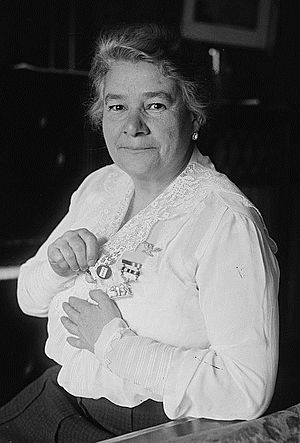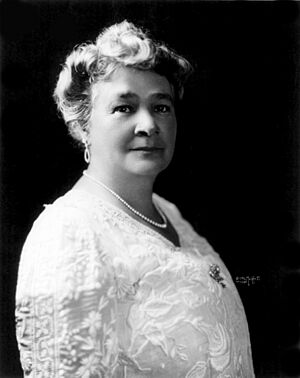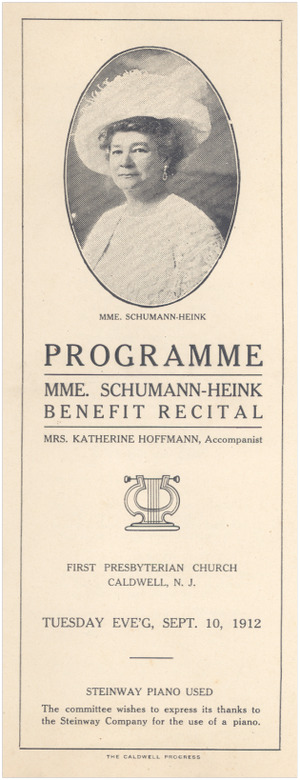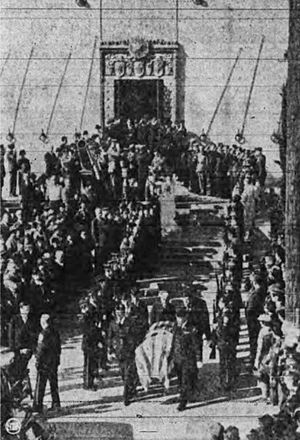Ernestine Schumann-Heink facts for kids
Quick facts for kids
Ernestine Schumann-Heink
|
|
|---|---|

Schumann-Heink in 1918
|
|
| Born |
Ernestine Amalie Pauline Rössler
15 June 1861 Libeň, Kingdom of Bohemia, Austrian Empire
|
| Died | 17 November 1936 (aged 75) |
| Other names | Tina Rössler |
| Spouse(s) |
Johann Georg Ernst August Heink
(m. 1882–1893)Curt Paul Schumann (m. c. 1895–1905) William Rapp, Jr.
(m. 1905–1915) |
| Children | August (1883–1918) Charlotte (1884–?) Henry (1886–1951) Hans Hugo Herman (1887–1916) Ferdinand (1893–1958) Marie (1896–?) George Washington (1898–1979) Walter Schumann |
| Parent(s) | Hans Rössler Charlotte Goldman |
| Signature | |
Ernestine Schumann-Heink (June 15, 1861 – November 17, 1936) was a famous opera singer. She was born in Bohemia, which is now part of the Czech Republic. Ernestine was known for her amazing voice, which was very flexible and had a wide range. She became an American citizen later in her life.
Contents
Early Life and Musical Beginnings
Ernestine Amalie Pauline Rössler was born on June 15, 1861, in Libeň, Bohemia. This area is now part of Prague, Czech Republic. Her family spoke German. Her father, Hans Rössler, was a former cavalry officer who became a shoemaker. Her mother, Charlotte Goldman, was from Italy. Ernestine's grandmother believed she would have a successful career.
When Ernestine was three, her family moved to Verona, Italy. In 1866, during a war, they moved to Prague. There, she went to the Ursuline Convent school. After the war, her family moved to Podgórze, near Kraków, where she attended another convent school.
At age thirteen, Ernestine's family moved to Graz, Austria. Here, she met Marietta von LeClair, a retired opera singer. Marietta agreed to give Ernestine voice lessons, which helped her develop her talent.
First Performances and Opera Debut
In 1876, at age 15, Ernestine had her first professional performance. She sang as an alto soloist in Beethoven's Ninth Symphony in Graz.
Her first opera performance was on October 15, 1878. She was 17 years old. She sang the role of Azucena in the opera Il trovatore at the Royal Opera House in Dresden. For four seasons, she was the main contralto singer there.
First Marriage and Career Growth
In 1882, Ernestine married Johann Georg Ernst Albert Heink. He was a secretary at the Semperoper in Dresden. Because of their marriage, both lost their jobs. Ernestine later found a job at the Hamburg Opera and rejoined her husband.
She had four children with Johann: August, Charlotte, Henry, and Hans. After some time, Johann lost his job again. Ernestine and Johann divorced in 1892.
Breakthrough Roles in Opera
Ernestine's big break came when another lead singer had an argument with the Hamburg opera director. The director asked Ernestine to sing the main role in Carmen without any practice. She did, and everyone loved it!
The next night, the other singer canceled her role in Le prophète. Ernestine stepped in again, without practice. She also replaced the singer as Ortrud in Lohengrin the following evening. Because of her amazing performances, she was offered a ten-year contract.
In 1887, Ernestine sang for famous composer Johannes Brahms. She was supposed to sing in a series of Mozart performances, but she had to cancel. This was because her fourth child, Hans, was born.
Second Marriage and American Citizenship
After her first marriage ended, Ernestine married Paul Schumann in 1892. Paul was an actor and director in Hamburg. Ernestine gained a stepson named Walter. She also had three more children with Paul: Ferdinand, Marie, and George Washington. George Washington was born in New York City. Her son, Ferdinand Schumann-Heink, later became a character actor in Hollywood movies.
Paul passed away in Germany in 1904. While dealing with legal matters, Ernestine decided to become an American citizen. She filed her papers in 1905 and officially became a U.S. citizen on March 3, 1908.
International Opera Career
Schumann-Heink performed with famous conductor Gustav Mahler in London in 1892. She became very well known for singing in operas by Richard Wagner. She had a long and successful connection with the Bayreuth Festival, a famous Wagnerian music festival, from 1896 to 1914.
Ernestine first performed at the Metropolitan Opera in New York City in 1899. She sang there regularly until 1932. She made her first musical recordings, called "gramophone" performances, in 1900. Many of these early recordings are still available today. Even with some small imperfections, her singing technique was very impressive.
Third Marriage and Life in America
On February 11, 1905, Ernestine became an American citizen. On May 27, 1905, she married her manager, William Rapp, Jr., in Chicago, Illinois. She was 43 years old.
They lived in North Caldwell, New Jersey, from 1906 to 1911. Then, she moved to a large farm near San Diego, California, in an area now known as Mt. Helix. She lived there for most of her life, and her house is still standing.
In 1909, she created the role of Klytaemnestra in the first performance of Richard Strauss's opera Elektra. She didn't think highly of the opera, calling it "a fearful din." Strauss, the composer, once told the orchestra to play "Louder! I can still hear Madame Schumann-Heink!"
Ernestine separated from William Rapp in 1911 and they divorced in 1914.
Helping Others and Supporting the Troops
While living in New Jersey, Schumann-Heink helped honor President Grover Cleveland. She performed a concert in 1912 to raise money to buy Cleveland's birthplace and turn it into a museum. She became the first lifetime member of the group that created the museum.
During World War I, Schumann-Heink strongly supported the United States and its soldiers. She performed for the troops and raised money for things like Liberty Bonds and the Red Cross. She toured the country to help with the war effort. This was special because she had relatives fighting on both sides of the war. Her sons August, Walter, Henry, and George Washington all served in the United States Navy.
Later Years and Legacy
In 1926, Ernestine first sang Stille Nacht (Silent Night) on the radio for Christmas. She sang it in both German and English. This became a Christmas tradition for radio listeners in the U.S. until 1935.
In 1927, she appeared in an early sound film called Vitaphone. This might be the only surviving video of her singing. She lost most of her money in the Wall Street Crash of 1929. This meant she had to start singing again at age 69.
In 1926, at 65, she began a weekly radio show. She also planned to "teach forty American girls" how to sing. She often advised women to focus on raising children. Her last performance at the Metropolitan Opera was in 1932, when she was 71 years old. She sang the role of Erda in Der Ring des Nibelungen.
Death and Memorials
Ernestine Schumann-Heink passed away from leukemia on November 17, 1936, in Hollywood, California. She was 75 years old. Her funeral was held by the American Legion. She was buried at Greenwood Memorial Park in San Diego.
Her personal collection of items was given to the Smithsonian Institution. On Memorial Day, May 30, 1938, a bronze plaque honoring Schumann-Heink was revealed in Balboa Park, San Diego. The plaque reads:
In loving Memory of Mme. Ernestine Schumann-Heink. A Gold Star Mother. A Star of the World
Notable Operatic Roles
| Role | Opera | Composer | Stage | Year |
|---|---|---|---|---|
| Azucena | Il Trovatore | Verdi | Dresden Opera, Ernestine’s operatic debut | 1878 |
| Brangäne | Tristan und Isolde | Wagner | ||
| Carmen | Carmen | Bizet | Hamburg Opera, Ernestine’s first major role at the Hamburg opera | 1886 |
| Fidès | Le Prophète | Meyerbeer | Hamburg Opera | 1886 |
| Ortrud | Lohengrin | Wagner | 1886 | |
| Adriana | Rienzi | Wagner | ||
| Amneris | Aida | Verdi | ||
| Leonora | La Favorita | Donizetti | ||
| Katisha | The Mikado | Gilbert and Sullivan, | ||
| Marthe | Faust | Gounod | ||
| Mary | Der Fliegende Hollander | Wagner | ||
| Witch | Hansel and Gretel | Humperdinck | ||
| Erda | Siegfried | Wagner | Theater Royal Drury Lane, London, Ernestine’s English debut | 1892 |
| Prince Orlofsky | Die Fledermaus | Strauss | 1894 | |
| Waltraute | Götterdämmerung | Wagner | Bayreuth, Ernestine’s first performance at the Bayreuth festival | 1896 |
| Ortud | Lohengrin | Wagner | Chicago Opera, Ernestine’s US debut | 1898 |
| Ortud | Lohengrin | Wagner | New York, Ernestine’s Metropolitan Opera debut | 1899 |
| Clytemnestra | Elektra | Strauss | Dresden, world premiere | 1909 |
| Erda | Rheingold | Wagner | Metropolitan Opera, New York, Ernestine’s final operatic performance | 1932 |
See also
 In Spanish: Ernestine Schumann-Heink para niños
In Spanish: Ernestine Schumann-Heink para niños





